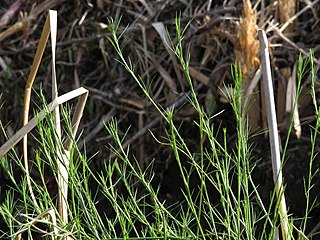
Psoralea is a genus in the legume family (Fabaceae) with 111 species of shrubs, trees, and herbs native to southern and eastern Africa, ranging from Kenya to South Africa. In South Africa they are commonly referred to as fountainbush (English); fonteinbos, bloukeur, or penwortel (Afrikaans); and umHlonishwa (Zulu).

Atalaya is a genus of eighteen species of trees and shrubs of the plant family Sapindaceae. As of 2013 fourteen species grow naturally in Australia and in neighbouring New Guinea only one endemic species is known to science. Three species are known growing naturally in southern Africa, including two species endemic to South Africa and one species in South Africa, Eswatini and Mozambique.

Umtiza is a monotypic genus in the legume family Fabaceae containing the single species Umtiza listeriana. This tree is endemic to a small coastal portion of the Eastern Cape in South Africa.

Frithia pulchra, the fairy elephant's feet, is a species of flowering plant in the fig‑marigold family Aizoaceae, endemic to Gauteng Province, South Africa. Its natural habitat is temperate grassland with high summer rainfall. A tiny stemless succulent growing to just 10 cm (3.9 in) tall and 20 cm (7.9 in) broad, it has bulbous oblong leaves with leaf windows at the tip; and magenta and white daisy-like flowers in winter. During periods of drought it has the ability to shrink beneath the soil surface, thus avoiding excessive desiccation, but making it extremely difficult to find.

Greyia flanaganii, commonly known as the Kei bottlebrush, is a species of plant in the Francoaceae family. Greyia flanaganii is one of the related species of the taxonomically isolated and endemic southern African family, the Greyiaceae. Greyia flanaganii is endemic to the Eastern Cape Province of South Africa. It is named after Henry George Flanagan, a South African farmer and botanist from Komga, Eastern Cape, South Africa.

Gymnosporia bachmannii is a species of plant in the family Celastraceae. It is a shrub or tree endemic to the Cape Provinces and KwaZulu-Natal in South Africa. It is threatened by habitat loss.
Homalium rufescens is a species of plant in the family Salicaceae. It is endemic to South Africa. It is commonly called the Small-leaved Brown-Ironwood.
Nuxia glomerulata is a species of plant in the Stilbaceae family. It is endemic to South Africa, where it has a restricted range between Pretoria and Zeerust. It resembles Nuxia congesta but the leaves are more elliptic, leathery and glabrous. It is threatened by habitat loss.
Prunus arborea is a species of plant in the family Rosaceae. It is found in Indonesia, Malaysia, Singapore, and Thailand.

Pseudoscolopia is a genus of plants in the family Salicaceae, which contains a single species, Pseudoscolopia polyantha. It is endemic to South Africa, where it is native to the Cape Provinces and KwaZulu-Natal. It is threatened by habitat loss.

A not evaluated (NE) species is one which has been categorized under the IUCN Red List of threatened species as not yet having been assessed by the International Union for Conservation of Nature.

Luehea is a genus of trees in the family Malvaceae.

Bursera penicillata is a Mexican species of trees in the frankincense family in the soapwood order. It is widespread in much of Mexico from Sonora and Chihuahua to Oaxaca and Veracruz.

Hauya elegans is a species of flowering plant in the Onagraceae family. It is native to Oaxaca and Chiapas, Mexico to Honduras, Costa Rica, and Guatemala.

Protea namaquana, also known as the Kamiesberg sugarbush, is a flowering plant which belongs to the genus Protea. The plant is endemic to the southwestern Cape Region of South Africa, in particular the Kamiesberg mountains of Namaqualand in the Northern Cape province. The species has a worldwide distribution of only 18 km2. It is regarded as critically endangered. In the Afrikaans language it has the vernacular name is Kamiesbergsuikerbos.

Psoralea fascicularis, the large-stipule fountainbush, is a species in the pea or Fabaceae family. It is endemic to the Western Cape province of South Africa where it has been red listed as endangered (EN) by the International Union for Conservation of Nature (IUCN) Red List of Threatened Species due to its declining population.

Serruria glomerata, the cluster spiderhead, is a flower-bearing shrub that belongs to the genus Serruria and forms part of the fynbos. The plant is native to the Western Cape, it occurs on the Cape Flats and Cape Peninsula. The shrub is erect and grows only 40 cm tall and bears flowers from August to October.

Paranomus sceptrum-gustavianus, the King Gustav's sceptre, is a flowering shrub that belongs to the genus Paranomus and forms part of the fynbos. The plant is native to the Western Cape, South Africa.

Paranomus dregei, the scented sceptre, is a flowering shrub belonging to the genus Paranomus. The plant is native to the Western Cape, South Africa.

Psoralea cataracta is a species of flowering plant in the family Fabaceae. It was declared extinct in 2008 in the Red List of South African Plants, with a single specimen collected from the Tulbagh Waterfall in 1804. It was rediscovered 200 years later by Brian Du Preez in November of 2019 in the Winterhoek Mountains near Tulbagh. It is endemic to the Western Cape. It is also known by the name waterfall fountainbush.


















